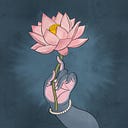The Nāga Kings
Śusruta, the ancient Indian physician and surgeon (7th century BC), says at the outset of his chapter on Kalpasthāna, or toxicology, while addressing snake-poison: “Innumerable are the famous Lords of Nāgas, headed by Vāsuki and beginning from Takṣaka, earth-bearers, resembling the sacrificial fire in their splendour (tejas), who incessantly cause thunder, rain and heat, and by whom this earth with her oceans, mountains and continents is supported, and who in their wrath might smite the whole world by their breath and sight. Homage be to those. With them there is no need of the healing art. But of those of the poison fangs that belong to the earth and bite human beings I will enumerate the number in the appropriate manner and in the proper order.”
In the Great Epics, as well as in Purāṇic literature, we meet with extensive lists of Nāgas. After the account of the bringing of the nectar by Garuḍa, recounted in the Ādi parva of the Mahābhārata, Śaunaka asks to hear the names of the sons of Kadru. Sauti then enumerates no less than seventy-eight Serpents, and declares at the end that these are only the principal Nāgas, as owing to their enormous number it would clearly be impossible to name them all. Another list of 68 Nāgarājas isenumerated in the Udyoga-parva and minor lists with some varying and a few shared names are found in the Sabhā Parva and the Mausala Parva.
The Harivamśa, Bhāgavata and other Purāṇas also contain different catalogues of the divine serpents, but the most extensive is undoubtedly found in the Nīlamata Purāṇa.
Nāga-kings bear names which are identical with those of certain royal personages in the Mahābhārata, for instance, mentions are made to a Nāgarāja named Dhṛtarāṣṭra, the father of the hundred Kaurava princes who are the opponents of the five Pandavas. Another Nāga-king who figures in the Great Epic is called Kauravya, which means “the scion of the Kuru race. Other royal names applied to Nāgas are Dhananjaya and Ambarīṣa; the former is a regular epithet of the Pandava hero Arjuna, and the latter is a name borne by a king of the race of Ikṣvāku, who figures in the legend of Śunaḥśepa according to the version found in the Rāmāyaṇa. The royal names of Āryaka, Janamejaya, Dilīpa, Pṛthuśravas; along with Udayana, Rāghava, and Baladeva mentioned in the Mahāvyutpatti also fall under the same category.
There are multiple theories speculating as to why serpents were worshipped as kings, one of them being that ancient Indian rulers might have sometimes been worshipped in the form of snakes after their death. There certainly are legends about kings who were changed into snakes in consequence of a curse and as a punishment of their evil deeds. A well known example is the story of Nahuṣa, an ancient king, who, after having been raised to the throne of Indra, in his presumption insulted the seven Sages, and, being cursed by Agastya, was doomed to live as a snake for ten thousand years. The Rājataraṅgini relates of a mighty monarch of Kashmir, Damodara by name, who wished to bring water to the plateau which still is known as Damdar Udar. Once hungry Brahmins came to him and begged for food, but the king said: “ I do not give food until I have bathed. Take yourselves off (sarpata).” Then they cursed him : “Be thou a snake (sarpa).”
The chronicler adds : “Even to this day people recognize him by the steam of his breath, which the curse has made hot, as he rushes about in search of water far and wide on the Damdar Udar.”
In the lists of divine serpents found in epic literature Śeṣa (or Anantā) usually figures first. He is often extolled as the sovereign of all Nāgas, but there are other prominent Nāga-rājas, especially Vāsuki, for whom the supreme rank is claimed. In the Bhagavadgīta (10.28–29) both are mentioned one after the other, wherein Śri Kṛṣṇa, equates himself to Väsuki, considered as the foremost among the snakes (sarpa), and Anantā, the chief of the Nāgas.
आयुधानामहं वज्रं धेनूनामस्मि कामधुक् |
प्रजनश्चास्मि कन्दर्प: सर्पाणामस्मि वासुकि: ||
Of the weapons, I am Vajra (the thunderbolt), among the cows I am Kāmadhenu; of the causes of procreation I am Kāmadeva; and amongst the serpents I am Vāsuki.
अनन्तश्चास्मि नागानां वरुणो यादसामहम् |
पितृणामर्यमा चास्मि यम: संयमतामहम् ||
Of the snakes I am Anantā; amongst the water-deities I am Varuṇa; Of the pitṝ (departed ancestors) I am Āryama; of the enforcers of law I am Yama.
References:
- Indian Serpent-lore: Or, The Nāgas in Hindu Legend and Art by J. Ph. Vogel
__________________________________________
If you find value in my work, I hope you consider becoming a patron. Hindu Aesthetic requires a lot of time and effort and your support would mean that I can continue bringing you the highest quality content. You can also reach out to me to make a one-time donation via GPay. Link to my Patreon:
